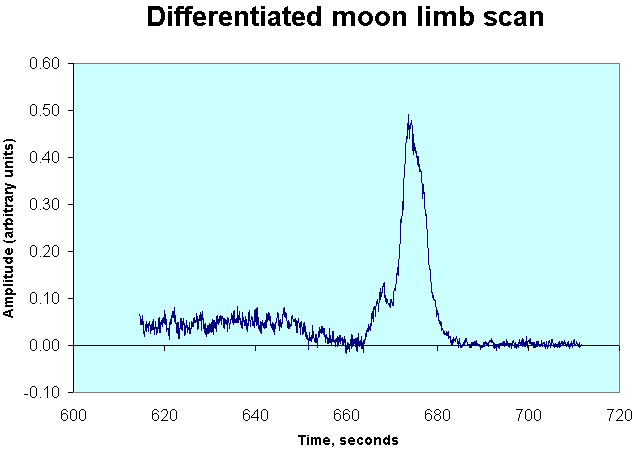First Light with the VertexRSI Antenna
Jeff Mangum
Antonio Perfetto
![[ALMA Vertex RSI Prototype Antenna at the VLA]](images_news/vertex_rsi_bigshadow.jpg)
On the night of January 13-14, 2003, the ALMA project attained a significant milestone. Using the first evaluation frontend installed on the VertexRSI antenna, millimeter-wave measurements of the total power emission from the Moon at 1mm and 3mm were successfully acquired.
These measurements of the Moon have allowed for some crude estimates of the basic antenna performance. For example, the radiometric beam shape was measured by first peaking-up on the radiometric signal from the Moon and allowing the Moon to drift out of the radiometric beam. By differentiating the total power measurements as the radiometric beam drifts over the edge of the Moon, a crude estimate of the radiometric beam shape can be made. This differentiated signal is shown in the figure.
A gaussian fit to the main peak in the Figure gives a measured beam size (FWHP) of 73.2 and 75 arc seconds, in successive observations. The expected antenna beam size for a 12 meter antenna at 95 GHz is 66". The larger than theoretical beam width may be a result of the telescope being out of focus (focus control is not yet available). This larger beam size could also result from imperfect initial alignment of the telescope beam on the center of the Moon, so that the Moon's limb is not perpendicular to the Moon's drift direction as it crosses the telescope beam.
The peak just before ~670 seconds in the figure is believed to be a real antenna sidelobe. This sidelobe is most likely a result of imperfect positioning of the subreflector. Both focus positioning and subreflector would normally be aligned very carefully before normal observations. The absence of detectable emission beyond about 685 seconds indicates a very low sidelobe level beyond the vicinity of the main beam.
 |
| Differential receiver output at 95 GHz over a period of about 100 seconds, as the moon drifted off the radiometric beam. The amplitude is proportional to differentiated receiver power output, in uncalibrated units. The time is shown in seconds (arbitrary start point). One second of time corresponds to 13.7 arcseconds on this plot. The emission detected before 660 seconds results from variations in lunar temperature as the beam drifts over the lunar surface. The data beyond about 690 seconds correspond to blank sky. At approximately 660 seconds, the beam begins to drift off the trailing edge of the moon. At approximately 675 seconds, the beam is exactly on the edge of the moon, giving the maximum differentiated response. By about 685 seconds, the antenna beam is completely clear of the lunar emission. The observations described here took place just before 07:00 UTC on January 14th. |
The success of these measurement is due to the hard work of:
- ALMA Tucson Electronics Division
- ALMA/US Antenna Division
- Darrel Emerson
- Jeff Mangum
The National Radio Astronomy Observatory is a facility of the National Science Foundation, and is operated under cooperative agreement by Associated Universities, Inc.
Modified on Friday, 31-Jan-2003 15:54:29 EST